
A table saw is one of the essential tools in a workshop. Table saws are versatile cutting machines, ranging from small, light and portable tabletop saws, to large, kitchen table sized, quarter-ton behemoths. They’re capable of ripping 4-foot by 8-foot sheets of plywood, with a single, long and precise cut, or cutting tiny slivers of wood smaller than the thickness of a pencil all to the same identical size.
If you’re planning on upgrading your table saw, or starting to build out a new workshop, you will find the information you need to make your decision here.
Page Contents
The 4 Categories of Table Saws
There are 4 main categories of table saws: Jobsite, Contractor, Hybrid and Cabinet. Each one has benefits and drawbacks, but they all try to find a balance that works for their particular woodworking niche. Portability, table stability, cut accuracy, and motor power all work against each other, so each category of table saw uses a different balance of these factors.
Jobsite Table Saws (Bench-top Saws/ Tabletop Saws/ Portable Saws)
Jobsite table saws are the smallest and least stable of all the saws. Portability is the main feature of a jobsite saw. You want to be able to move this saw around to where you need it on a jobsite. Weighing between 50 to 100 lbs., they are light enough and small enough for one person to wheel or carry from location to location.
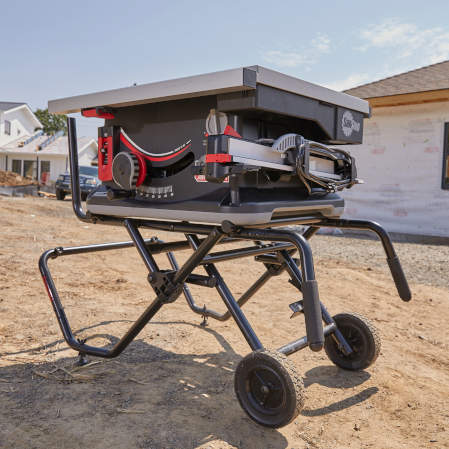
The main feature of these saws is that you can quickly pick them up and put them where they’re needed. No one wants to carry lumber to the saw and back when you can put the table saw where the wood needs to be cut. You put a jobsite saw where you need it, and when you need it somewhere else, you can pick it up or wheel it there.
Jobsite saws are also the cheapest of all table saws. Quality models will typically cost upwards of $600. With mid-range bench-top models priced around $250. The top of the line SawStop jobsite saw is priced at $1,500. As you can see, there is a wide range in pricing for these saws.
The drawbacks of these saws are they are the smallest, and the least stable. Since they are small, you can’t rip full sheets of plywood, or large/long pieces of lumber. The tabletop is simply too small to accommodate large pieces of lumber safely.
The tabletop is made of metal, usually aluminum to reduce weight. Aluminum weighs less than a heavier, sturdier iron tabletop, but it also does not contribute to stability as well as an iron tabletop. Most of jobsite saws remaining parts are made from plastic. Plastic flexes and bends when you put stress, weight and force on it. Jobsite saws will flex when sliding wood across the table during a cut. This lack of stability often leads to inaccurate cuts.
The tendency to flex and move during use also forces the blade and fence out of alignment. With a jobsite saw you will have to check and adjust the saw blade’s alignment with the fence often. With jobsite saws, if you want highly accurate cuts, you really must square everything after every few cuts. Quite a hassle if you are making a lot of cuts that need to be precise.
Outside of a high end saw like a Bosch or SawStop, most jobsite saws rarely have an arbor long enough to accommodate dado blades and dado sets. If you plan on using dadoes, you can probably rule out almost all jobsite table saws.
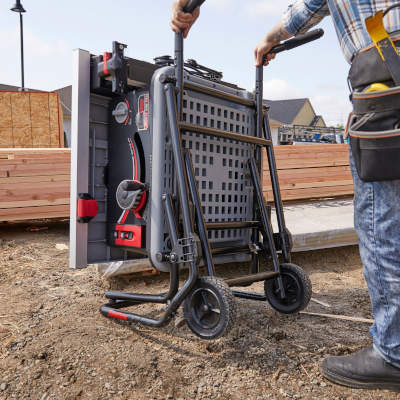
These saws also lack the necessary power to cut thick hardwoods. With weight being a concern, a smaller direct drive motor is used. These motors will get bogged down while cutting through hardwood, and the motor will lock up. The stress of a complete stoppage on a direct drive motor will cause it to burn out prematurely.
Larger table saws use a belt drive motor instead of a direct drive motor, so when they get bogged down during a cut, the motor can keep spinning while the belt takes all the stress. There is a section lower on the page that goes further in depth on the differences between the motors.
Sawdust collection. It is laughable at best with a jobsite saw. Most manufacturers try to have some semblance of dust collection, but with limited space and weight concerns, it becomes an afterthought. So you can expect a messy cleanup. Wear a paper respirator mask when using a table saw with poor dust collection. High end jobsite saws, like the SawStop have a dust collection port at the rear, but if you don’t connect it to to something to collect the dust like a shop vac, it will still make a mess.
Jobsite saws are best suited for construction sites, or any place where portability and size is a primary concern. They are easy to move to where you need them, making them ideal for construction framing. They are good for cuts where accuracy is not of the utmost importance. If you’re a cabinetmaker or a furniture builder, a jobsite saw will not make accurate enough cuts.
Contractor Saws
The next step up in the table saw family is the contractor saw, also called open leg table saws. These saws are larger and heavier than jobsite saws. They were originally designed to be portable counterparts to full size cabinet saws before the advent of small jobsite saws in the 1980s.
The larger size and greater power allow contractor saws to be used for larger projects than jobsite saws. The increased weight (250-300 lbs.) gives them substantially more stability for more accurate cuts. And the larger size allows for cutting larger stocks of lumber, without sacrificing all portability. The increased power allows for cutting of all types of wood, including thick hardwoods.
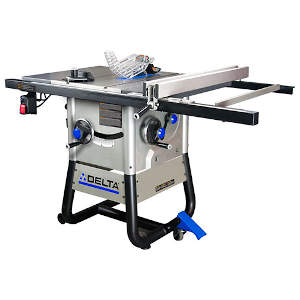
Contractor saws can be best described as dependable, no-frills design at an affordable price. Mid-range contractor saws can be found at a $600-650 price point, with a high end SawStop costing over $2,000.
These saws can be set up to make ultra-accurate cuts, which are good for projects up to and including basic furniture making and light cabinetry work. Some contractor saws have an arbor long enough to fit dado sets. So, if you plan on using dadoes, check the individual saw to see if the arbor is capable. These saws are the most affordable option for hobbyists and small workshops looking to balance quality, value and long operating life.
A contractor saw will typically have a longer lifespan than a jobsite saw. The larger motor and more robust materials used versus a jobsite saw make it more durable for day-to-day work, while also providing reliable, accurate cuts for a longer period in-between squaring and adjustment.
However, these saws make some compromises in the quest for affordability. Contractor saws are much heavier than jobsite saws. You will not be moving this saw to different locations at a jobsite too easily. They are designed to be set up in one spot and only moved when necessary.
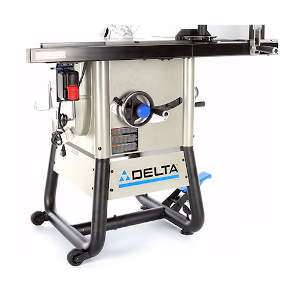
Contractor saws use open leg stands. This makes for poor sawdust collection. These saws aren’t optimized to contain every bit of sawdust. The motor hangs off the back of the table which helps in portability by making it easy to take off when moving the saw, but virtually eliminates any effective dust collection.
The open leg design also allows sawdust out into the open air. You can cutdown on the sawdust by enclosing the open legs in MDF or plywood, or you can wrap them in shrink wrap for some no frills dust collection help.
Almost all contractor saws come with a solid cast iron table, which helps provide to its overall stability. However, some saws do not come with solid cast iron extension wings, but with lighter stamped metal or aluminum extension wings. Although cast iron extension wings increase the overall weight of the saw, they also contribute to the overall stability of the saw.
Extra weight reduces vibration during use, leading to individual components of the saw lasting longer. The trunnions that hold the saw to the table, the gearing, the motor, the fence, etc. are all adversely affected by vibration. Less vibration limits the ability for the fence and the miter to go out of alignment, and for connected parts to vibrate loose.
The trunnions, gearing, arbor bolt and motor are also not as robust as you will find on a more expensive cabinet or hybrid saw, but they are much better than what’s found on a jobsite saw.
Hybrid Saws
Hybrid saws are relatively new design by table saw manufacturers. These saws are designed to fill in the longstanding price gap between contractor saws and cabinet saws. Hybrids capture some of the valuable features of a cabinet saw while remaining at a price that’s still within reach for hobbyists and homeowners. p
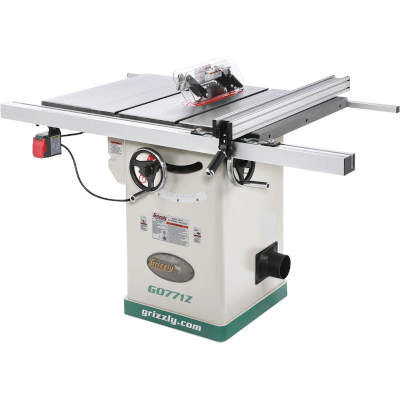
The base will be a fully enclosed, tabletop to floor cabinet-style base, or a small enclosed base with open legs underneath. The motor is mounted inside the enclosure on both types. Sturdier construction in hybrid saws allow for more precise alignment of the blade with the miter slot, and a fence that will not need re-alignment as often, compared to a contractor or jobsite saw.
Hybrids have the weight needed to remain stable during use and reduce vibration to internal components like the trunnions, motor, and gearing, making them last longer. The arbor bolts are sturdier than in a contractor saw, and they are always long enough to accommodate dado blades and sets. Hybrids also have a large enough table to accommodate ripping full sheets of plywood.
The motors on hybrids are in the 2 to 4 horsepower range, which is the maximum power you can run on a standard 120V electric outlet. There’s no need to run 220V line to the saw as you would with a cabinet saw. The high-powered motor will cut pretty much anything you can throw at it, including thick hardwoods.
Hybrid saws can run from $800 for a low end model to up to $2,000 for a high end hybrid. A quality mid-range model will sell for less than $1,500.
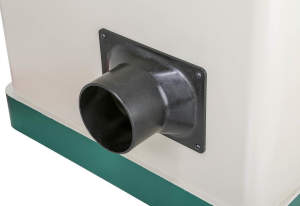
Sawdust collection is very good compared to a contractor or jobsite saw. The base on a hybrid saw is enclosed, so it does a good job keeping the dust contained to underneath the saw. Most hybrid saws come with a port for dust collection, which makes it easy to hook up to a shop vac or to a dust collection system.
The main downside of a hybrid saw is that it’s not a full-blown cabinet saw. The components on a hybrid saw are very good compared to contractor or bench-top saws, but not as good as a cabinet saw where they are more robust and better laid out. However, since a hybrid is essentially a smaller version of a cabinet saw, the general consensus in the woodworking industry is that hybrids are becoming the go-to table saw for hobbyists and homeowners as they offer many of the advantages, and solid construction of a cabinet saw at a lower price point.
Cabinet Saws
Cabinet saws are the biggest saws of the bunch. They are the ultimate saw for all woodworkers- hobbyists and professionals alike. They are built to meet more exacting standards than a hybrid or contractor saw. The table on a cabinet saw will be flatter, the motor and internal components will be stronger and more robust, and the fence and miter systems will be more reliably accurate. You could go years before the anything needs to be re-squared and aligned on a cabinet saw.
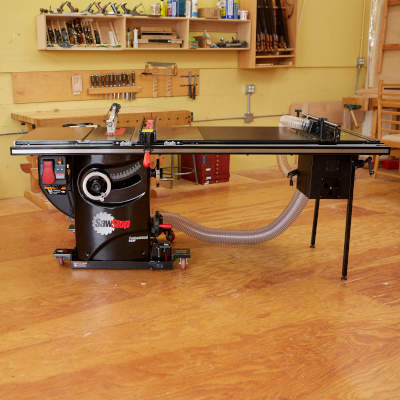
They are called cabinet saws because all the internal components are fully enclosed within the base which looks like a cabinet. During operation, a cabinet saw is quieter than the other saws because the motor is located within the cabinet, muffling the noise it makes. Dust collection is the best- since everything is enclosed within the base, sawdust is almost totally contained. Cabinets saws are also setup to be easily attached to a dust collection system or shop vac.
Cabinet saws are also the heaviest and most stable of all table saws. Cabinet saws can weigh over 600 lbs., so you must decide where it would be best placed in your workshop because you won’t be able to move it around easily after set-up.
The saw top and the extension wings will both be made of cast iron and/or steel. The trunnions, gearing, pulleys, bearings, and even the arbor are heavy duty, leading to a long, dependable service life. The increased weight minimizes vibration, so the internals last longer, and everything stays in alignment for a long period of time.
The design of the trunnion is better than that of a hybrid or a contractor saw. In a cabinet saw, the trunnion is mounted to the base. This makes for easier alignment of the blade with the fence and the miter slot. On a hybrid saw, the trunnions are usually mounted to the table itself, which can lead to the tabletop sagging after a while because the weight of the motor is pulling down on the tabletop. This is not the case in a cabinet saw.
Cabinet saws require more power for their motors. The motors range from 3 to 5 horsepower, but they require a 220V circuit. If you don’t have a 220V outlet, you will have to run one to power a cabinet saw. The high power motor cuts through anything you can throw at without bogging down. Have to cut some really hard hardwoods like lignum vitae? A cabinet saw will power through it with no problems.
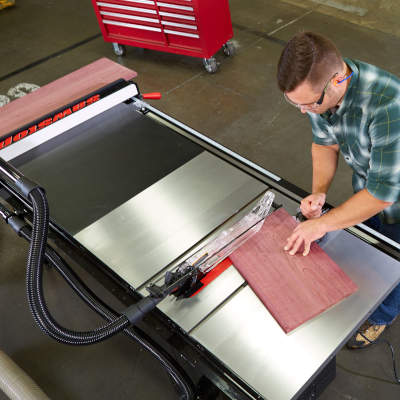
The real downside of owning a cabinet saw is the cost. The budget models start around $1,500. The biggest value, most bang-for-your-buck models fall in the $2,000 to $2,500 range. A high end cabinet saw will be around $3,000 to $3,500 depending on what features you want. And the top of the line industrial models cost over $5,000.
Spending this much money for a single tool is a big commitment. You can purchase a good hybrid model and a bunch of other tools for the same price of a mid-range cabinet saw. When making decisions like this, I like to list the features I want and compare them to the features that I will actually use regularly and make my decision from there.
Even with the substantial price, cabinet saws are the preferred saw of hardcore hobbyists and woodworking professionals because of their superior performance.
Important Features To Look For On A Table Saw
Fences
There are so many table saw fences you can choose from; it would take me too long to cover all of them. So instead, I will cover some of the most popular choices amongst the woodworking community. If you don’t see a table saw fence you’re interested in listed here, that doesn’t mean that it’s a bad fence at all. You can find plenty of well-written information on fences for virtually every table saw fence manufactured today on woodworking forums and websites. YouTube is also a great choice.
Biesemeyer Fence (and the many ‘Biesemeyer-style’ fence systems)
You might hear that the Biesemeyer fence is the best, the gold standard, the best of the best. This was true up until not too long ago. When the Bies-style was first introduced in the 1980s, it revolutionized table saw fence design with its T-Square style fence.
It was many times more sturdy than other fence systems around at the time. So, once you aligned it with the saw blade, it would last for what seemed like forever before going out of alignment. This made it much easier and more reliable to make repeatable cuts. It also saved countless hours because you no longer needed to remeasure and square the fence after moving it to make different sized cuts.
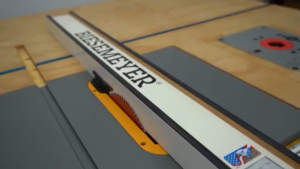
The main benefits of the Biesemeyer design that make it so popular are its stability, accuracy, versatility, ease of adjustments, and ease of replacing worn-out parts. It comes in 2 sizes: 30+ inch and 50+ inch, depending on how much space you have and how much space you need. The Biesemeyer fence is fairly heavy compared to other fences, but it slides easily on the fence’s rails which are installed onto the front and rear edge of the table saw.
The stability of a Biesemeyer fence comes from its heavy weight along with its strong front-locking T-Square design. The fence is made of steel and was much heavier than any of its predecessors, and even many fences today. The weight coupled with the strong lock down mechanism at the front rail of the table hold the fence securely in place.
Once you lock the fence down, you can be confident that there will be virtually no deflection at the rear of the fence. The fence will stay aligned with the blade even after you move it out of position. If you have problems with the fence deflecting when cutting something large like a full sheet of plywood, then you’ll have a problem with inaccurate cuts. The great stability is what gives the Bies fence superior accuracy.
The Bies fence is very accurate, especially compared to cheaper table saw fences. Although there are more accurate fence systems available, the Bies still stands out. It’s easy to make repeatable accurate cuts without having to constantly re-check the blade and fence alignment. By this I mean that if you make a cut for 12”, you can move the fence around to make a 15”, then a 6”, then a 1”, and come back to a 12” cut, and that 12” cut will be extremely close to the first 12” cut that you made. You can trust the tape measure on the slide rail to be accurate every time because of the stability of the Biesemeyer fence keeps everything in check.
This leads us to ease of adjustments. This might be a bit of a misnomer- it’s easy to adjust the fence to be parallel to the miter slot and the surface of the table. This is not the ease that I’m concerned with; I’m referring to the ease of not having to re-check the alignment of the fence after sliding it to a new position. This is a huge timesaver.
If you had to recheck the alignment after every time moving fence, you could easily double the time required to make all your cuts on a table saw. Accurate, dependable, and repeatable cuts are what elevated the Biesemeyer fence to its lofty status when it was first introduced.
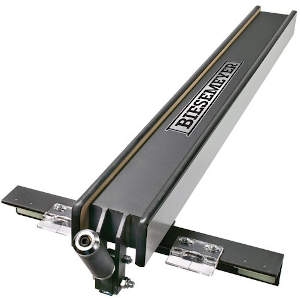
The last feature I want to cover is the ability to replace wear pieces. The surface of the face of the fence is prone to wear as lumber slides up against over and over. As the face of the fence wears down, it develops high and low spots which affect the accuracy of your cuts.
The replaceable face is usually made of ½-inch of a smooth material such as plastic or laminate. As the fence surface wears, you can replace it with whatever material you choose to keep the fence accurate. The wear pieces are also easily modified to can attach jigs for whatever advanced projects you are working on.
The Biesemeyer fence will hold up well for years in any setting, even in a professional shop setting. And it will not require much maintenance during its life span. All its superior qualities, and its long lasting durability make Biesemeyer fences among the best and highest regarded in the woodworking industry.
Nowadays, other manufacturers have caught up to the Biesemeyer fence and introduced fence systems that are just as solid as the Bies, if not better. Here are some other popular fence systems that are commonly discussed. There are many other fence systems that are also good choices, and some table saws come standard with a high quality fence system, so don’t think of these that are the only fences worth using.
Incra TS- LS Fence
The Incra TS-LS fence might be the most accurate fence currently available. Once it’s all set up and dialed in, it is dead on accurate and true to the measurement and will stay that way for a long time. You can make a cut, move the fence for 20 other cuts, and come back to the original cut size and the new cut will be precisely the same size as the original.
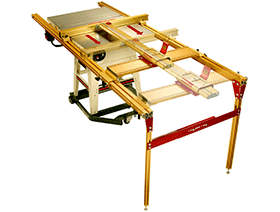
No other fence can match the precision, or the repeatability of the Incra fence. It’s nice to be able to go back to duplicate a previous cut later on in a project and be confident it matches the original without having to re-cut a whole new set. This might be overkill for some projects, but it is ideal if you need repeatable precision.
If you work with a lot of small pieces to cut, precision and tight tolerances are very important. Being able to make cuts precisely the first time and have the pieces fit together without sanding or trimming saves a lot of time.
The only thing that comes close would be to add a Wixey digital read out to a Biesemeyer or other high quality fence system. I cover the Wixey further down on the page.

The Incra fence comes in 32” and 52” sizes. The larger 52” fence is huge- see the picture above. It will take up a lot of horizontal space in a workshop. But it’s one of the few fences that can accommodate tools on the left side and the right side of the saw. You can put an extension wing router table on either side of your table saw, and the Incra can be used as a fence for the router, or whichever tool choose, with the same accuracy you have for your table saw.
One downside to the Incra fence is that it takes a few extra minor steps to lock it in place. There are two knobs to secure at the front rail, and the clamping mechanism on the fence itself. Most other fence systems use a single clamp at the front rail to lock the fence in place. It can take a while to get used to if you’re already accustomed to using a single clamp fence, but if you need an accurate and repeatable fence, it’s probably well worth it.
VerySuperCool Tools Fence System (VSC Fence)
The VerySuperCool fence is an aluminum extrusion fence that focuses on individual customization and versatility. It makes it easy to attach and use adapters, auxiliary fences, sacrificial fences, tools and other extrusions without having to use clamps that get in your way.
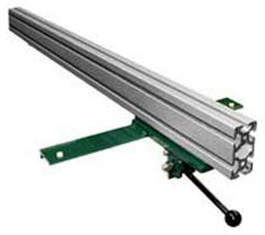
Auxiliary and sacrificial fences can be added on without having to make any adjustments to the main fence. You can have an auxiliary face fence like you would have on a standard Biesemeyer fence, and it can be easily slid off to put on a sacrificial fence to use for dado blades.
There’s a good chance that the VSC fence and T-Clamp will fit onto your existing fence’s rail system, especially if it’s a Biesemeyer or Bies-style fence. If you use a lot of jigs, the VSC fence is a great choice.
Wixey Saw Fence Digital Readout (Accessory)
The Wixey digital readout can provide accuracy and repeatability very close to, if not equal to the Incra LS fence. The Wixey can be added to an existing table saw fence, giving it similar accuracy to the Incra. If you already have a high-end fence on your table saw, the Wixey is a very nice add-on to get very precise accuracy without having to go for a whole new fence system.
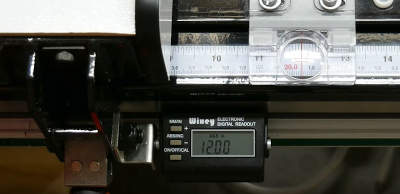
You can add the Wixey to both the right and left side of the saw blade and be able to maintain accuracy on the full length of the rail. Like the Incra fence, you can make a cut, move the fence, and still be able to come back to the original cut size and make an identical cut.
The Wixey matched with a Biesemeyer style fence is very close to as precise as an Incra fence, but it’s much faster to use due to how the Incra fence locks in place with 2 knobs and the clamp which takes a couple extra seconds.
Left and Right Tilt
This is the direction that you can tilt the blade for making beveled and angle cuts. Left tilt is considered the optimal of the two because the fence usually sits on the right side of the blade. With the blade tilted to the right on a table saw where the fence is on the right, there is a greater chance for the cut piece to bind or get caught against the fence. This presents a safety issue where kickback could occur, or the piece you’re guiding might get pulled up and across the blade, possibly causing your hands or fingers to make contact with the spinning saw blade.
If you have a right tilt blade, these issues can be alleviated by moving the fence to the left side of the blade. You can also flip the blade around, so the teeth are facing toward the back of the table and feed your cut from the rear of the table saw.
A potential safety issue with this idea is that the power switch might no longer be close to you, so if there’s a problem where power to the saw needs to be shut down, you will not be able unless you run to the opposite side of the table.
With that being said, go with what you are comfortable with. If you’ve been using a right tilt blade with a right side fence, then stick with it because it is familiar to you.
Arbor Length and Diameter
The arbor is the shaft where the saw blade attaches, directly or via belt, to the motor and transfers the torque from the motor to spin. There are two measurements to consider for the arbor. First is the length, and the second is the diameter.
The arbor length is how long the arbor is. The reason you would need a longer arbor is if you use dado stacks. Most, if not all, tabletop/ jobsite saws do not have an arbor long enough to accommodate single dados or dado sets. Pretty much all other categories of table saws will accommodate a dado set, but it’s a good idea to do your due diligence if you are in the market for a new saw.
Arbor diameter will determine what type of saw blades the table saw will use. There are two sizes- 5/8-inch and 1-inch. Neither has major advantages over the other. Typically, 7 ¼” to 10” saw blades will have a 5/8” arbor hole, and 12” to 16” blades will have a 1” arbor hole. 10-inch blades are the most common size for table saws.
When considering a table saw, the bearing shaft size and sturdy clamping hardware are more important than arbor size. A massive shaft assembly and huge 4” clamping nut on a 5/8” arbor is more preferable than a thinner shaft assembly with a 1.5” inch clamping nut on a 1” arbor.
Direct Drive vs. Belt Drive Motors
Belt drive motors are, without question, superior to direct drive motors (also called induction motors). Any cabinet saw you purchase today will use a belt drive motor. The only saws sold today with direct drive motors are tabletop and jobsite saws. They use direct drive motors because they need to be moved around often, and a direct drive motor is smaller and lighter than a belt driven one. Mobility is the only benefit of using a direct drive table saw over a belt-driven model.
Belt driven motors are better in all regards versus direct drive. Belt driven motors will last much longer, provide more torque, run quieter, run at a lower operating temperature, and provide greater cutting depth versus a direct drive motor.
Direct drive motors are also more likely to burn out when and if they get bogged down during a cut. A belt-driven table saw connects the motor to the shaft and arbor via a belt or pulley. When bogged down, the belt will slip while the motor continues spinning. This puts less stress on the motor since it is still free to spin. Whereas a direct drive motor is directly connected to the shaft and saw blade, so it absorbs all the stress when it’s bogged down.
Dust Collection
There is plenty of information you can find on dust collection and dust collection systems. It is really a topic of its own because you can tie almost every tool in a wood shop to a universal dust collector if you chose to. I covered dust collection on each type of table saw at the top of the page, so I’ll be brief.
A table saw makes a lot of saw dust. Higher end saws, in general, will have better dust collection features. Dust collection features to look for in a table saw are the ability to collect dust below the table and contain it there, along with dust collection ports above the tabletop, usually on the blade guard, and below the table where most dust is collected. Most sawdust ends up below the table to the ability to connect a vacuum to a dust collection port below the table is more helpful of the two.
Safety Features
A table saw might be the most dangerous tool you can own. You can lose a finger if you touch the spinning blade, or the saw itself can kickback a piece of wood you are cutting at a high velocity causing injuries. The saw can also cause kickback where the wood moves in an unpredictable manner and causes your hands or fingers to end up crossing paths with the blade. There’s no way to 100% safeguard against table saw accidents, but taking the necessary safety precautions will drastically limit those accidents.
Preventing Kickback
I’ve posted some tips for preventing table saw kickback here.
On/Off Switches
Another safety feature to look for in a table saw is an easily accessible on/off switch. If you’re cutting a sheet of plywood, and it feels like the wood is getting pinched, you want to cut power to the saw ASAP. A large diameter switch that can be operated by slapping it with your hand, your knee, or any part of your body in a hurry is ideal.
You don’t want a small switch that you can only toggle with a single finger because if a situation arises where the power needs to be cut off immediately, getting your finger to hit that switch will feel like threading a needle. And sometimes you will only have one shot to turn hit that switch before something bad happens.
It is also a good idea to have a sunken switch with a cover. This prevents the saw from turning on if you accidently hit it. If you have children running around the house, and they have access to the area where you keep your table saw, it’s a great idea to add a lock to the switch cover to prevent them from being able to turn on the saw.
Another switch option is a magnetic switch. A magnetic switch prevents the motor from restarting if there has been a power interruption. Imagine the power cuts out in the middle of making a cut. You walk away to check the breaker and suddenly the power comes back on and the table saw motor automatically turns back on. There’s a good chance for whatever your cutting to be kicked back by the table saw and cause damage to the work area, or to anyone standing in the way.
Riving Knife
The last time I was at local big box tool store checking out the tool selection, I don’t think I noticed any of their table saws on display not having a riving knife. These are all lower end jobsite saws mainly, but I’m confident that all table saws you can purchase new these days will come with a riving knife.
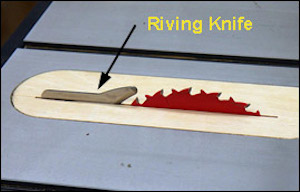
You should always make sure that if you’re purchasing a used saw, or even a new one, that it comes with a riving knife. It’s a pain in the neck to put an aftermarket one on, and you run might run into some problems such as the riving knife not raising and lowering with the saw blade, or the saw might not be set up to take a riving knife.
A riving knife sits behind the saw blade and prevents the wood you are cutting from getting pinched between the fence and the rear of the saw blade as it passes through the saw blade. A riving knifes raises and lowers with the saw blade, so it is always in optimal position for preventing kickback, and they never will obstruct the travel path of a cut. A riving knife is the top safety feature for preventing table saw kickback.
Splitter
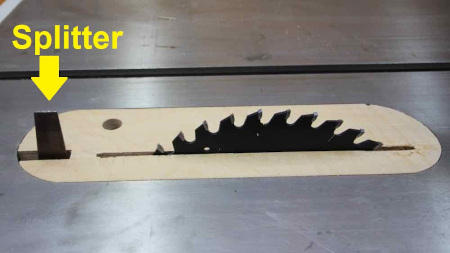
Table saws no longer are sold with splitters these days, but it you have an older table saw, it may use a splitter instead of a riving knife. Splitters do not raise and lower with the saw blade, so they can impede the travel path of the wood if you have the saw blade set for a low cut. Riving knives perform better, but a splitter does an adequate job at preventing kickback, and it is certainly better than not having anything at all.
Anti-kickback Pawls
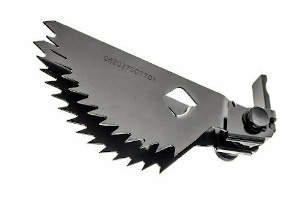
Anti-kickback pawls are a type of latch that reduces the chances of kickback. The pawls look like tiny saws with pointed teeth. They are mounted after the riving knife, and they sit so the teeth run across the top of the wood as it pushes past the saw blade. The pawls let the wood move freely toward the rear of the table saw, but if kickback occurs, they work to prevent the wood from moving back toward the front of the saw. The teeth are designed to dig into the wood if it begins to move backwards, holding it in place and hopefully preventing any kickback.
Blade Guard
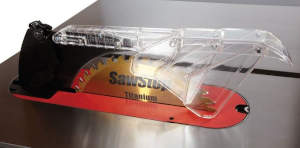
The blade guard is the clear plastic shroud that goes over the saw blade. It prevents you from sticking your fingers, or any other part of your body onto the saw blade. Most saw these days have a dust collection port attached to the blade guard so you can attach a hose from your shop vac or dust collection system.
Flesh Sensing Technology
Only found in SawStop saws sold in the United States, this safety feature makes the spinning saw blade immediately stop and retract back into the table if any part of your skin makes contact the saw blade. The science behind this tech is your skin produces a slight electric current, so when you touch the saw blade, the saw picks up on this electrical charge and triggers the stop mechanism.
The stop mechanism stops and retracts the saw blade into the table instantly. The blade is stopped by an aluminum brake that is shot into the spinning saw blade, and the blade is retracted into the table by the momentum created by the sudden stop. SawStop states that it takes 5 milliseconds for this process to take place.
If you see one in action, it’s actually pretty amazing. The only downside is that the saw blade is ruined by the aluminum brake after the safety mechanism is triggered. I’d say that is a fair tradeoff instead of losing a finger. There’s a demonstration in the video below.
Bosch also makes a table saw that has flesh sensing tech, but because of SawStop’s US patents, they cannot sell the saw in the United States.
Blade Height
Take a look at our page for recommendations on table saw blade height.
Push Sticks & Push Blocks
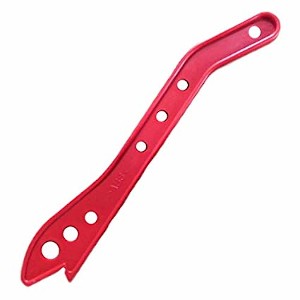
Ideally, you always use push sticks or push blocks while making a cut on a table saw. The sticks or blocks keep your hands safely away from the saw blade. They also make it easier to keep your body out of the direction of any possible kickback.
